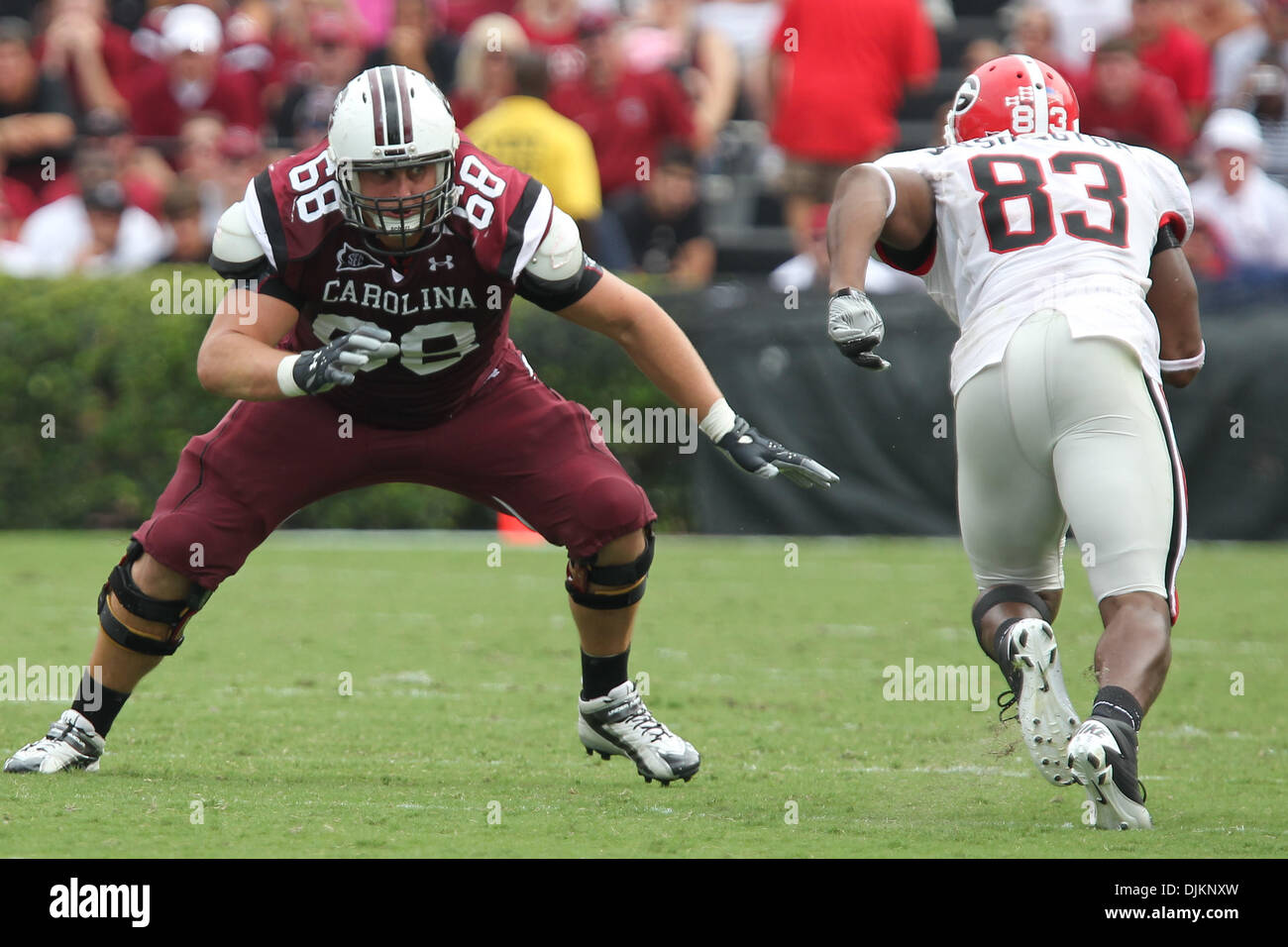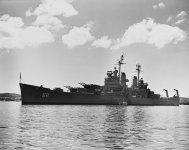USS Fanshaw Bay, CVE-70.
_transporting_aircraft_on_17_January_1944_(NH_106573).jpg/1280px-USS_Fanshaw_Bay_(CVE-70)_transporting_aircraft_on_17_January_1944_(NH_106573).jpg)
_transporting_aircraft_on_17_January_1944_(NH_106573).jpg/1280px-USS_Fanshaw_Bay_(CVE-70)_transporting_aircraft_on_17_January_1944_(NH_106573).jpg)
https://en.wikipedia.org/wiki/USS_Fanshaw_BayBattle off Samar
Fanshaw Bay and White Plains were located on the west flank, and therefore bore the opening volleys of the engagement. Beginning at 6:58, both of the carriers came under fire from the Japanese task group, which was situated about 16.6 mi (26.7 km) away. The Japanese were firing dye-marked shells to gauge their aim, and the escort carriers were, much to the concern of their command, straddled in plumes of colored water. The officers would certainly be more concerned if they were able to correspond the color of the dyed water to that of a particular Japanese ship, as plumes of red, green, blue, purple, pink and yellow dyed water started to dot the ocean. Unbeknownst to the crew, the pink dyes corresponded to the Japanese battleship Yamato, with its 18 in (460 mm) guns, the largest ever manufactured, and the yellow dyes corresponded to the Japanese battleship Kongo, with its 14 in (360 mm) guns. Fortunately for Fanshaw Bay's crew, as the shells slowly creeped up to her stern, she happened across a passing rain squall at 7:03, reducing visibility to just 0.5 mi (0.80 km).
At the same time that Fanshaw Bay was being harried by shells, the twelve aircraft that she had launched, joined by four fighters which had been on patrol, commenced attacks against the leading Japanese ships. Their attacks were mostly ineffective, mostly due to their light armaments and a general lack of coordination. The task group emerged from the rain squall by 7:23, but it was not until 7:50 that Fanshaw Bay came under concentrated fire again. At 7:50, four 8 in (200 mm) shells made impact with her hull, with another two missing just in front of her bow. One shell penetrated through a ventilator, killing two men as it tore into the carrier. Another shell passed under one of her Bofors guns, tearing the face off of one of her crew. Deflected by the gun's shield, the shell ricocheted over her flight deck. Another shell destroyed her catapult track, and resulted in a small explosion within her flag office. Four small fires had been kindled by these shells, but they were quickly put under control, along with a minor issue with flooding. Although four men had been killed in the attack, her operational capability was not significantly compromised. Rather, Fanshaw Bay's 5 in (130 mm) gun responded by firing against one of the leading Japanese cruisers, landing at least five hits against its superstructure.

_underway_in_November_1918_(19-N-16455).jpg/1280px-USS_Craven_(DD-70)_underway_in_November_1918_(19-N-16455).jpg)
_departs_Pearl_Harbor_160520-N-GO855-405.jpg/1920px-USS_Hopper_(DDG-70)_departs_Pearl_Harbor_160520-N-GO855-405.jpg)
.jpg/800px-Commodore_Grace_M._Hopper,_USN_(covered).jpg)

/cdn.vox-cdn.com/uploads/chorus_image/image/55756717/6_3687373.0.jpeg)
_underway_at_sea,_circa_in_1943.jpg/300px-USS_Blessman_(DE-69)_underway_at_sea,_circa_in_1943.jpg)



_in_Narragansett_Bay_1944.jpg)

_with_HSC-7_MH-60S_Sea_Hawk_helihoisting_cargo_during_underway_replenishment_151129-N-QD363-561.jpg/1280px-Bow_view_of_USS_Dwight_D._Eisenhower_(CVN-69)_with_HSC-7_MH-60S_Sea_Hawk_helihoisting_cargo_during_underway_replenishment_151129-N-QD363-561.jpg)
_underway_in_Guantanamo_Bay_on_10_January_1967.jpg)
.jpg)

_underway_at_sea,_circa_in_1944.jpg)
_flies_the_ship's_battle_flags_during_exercises_at_sea.jpg/1920px-US_Navy_090213-N-4774B-028_The_guided-missile_destroyer_USS_The_Sullivans_(DDG_68)_flies_the_ship's_battle_flags_during_exercises_at_sea.jpg)
_and_embarked_Carrier_Air_Wing_(CVW)_11_depart_San_Diego_for_a_scheduled_deployment_to_the_western_Pacific_Ocean.jpg/1920px-thumbnail.jpg)






